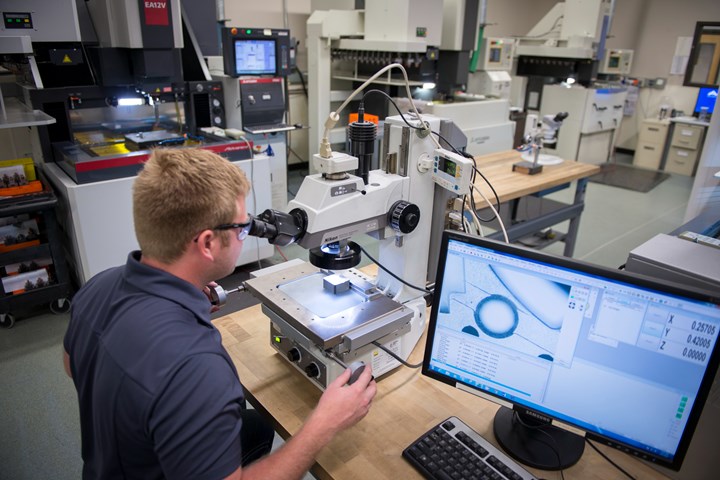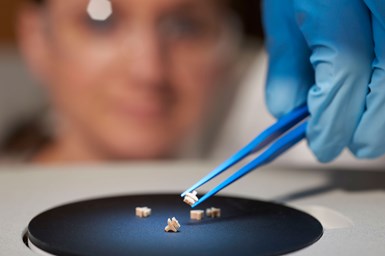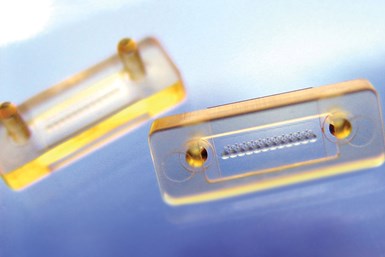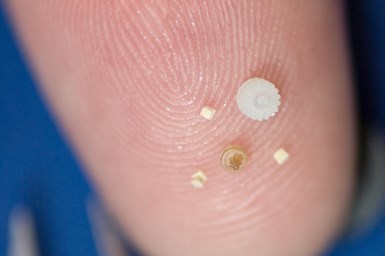
Accumold uses automated vision inspection on the press, robots, vision and laser measurement technology and noncontact white light interferometer equipment to measure micro features and surface roughness of molds and parts. Photo Credit, all images: Accumold
We are all aware of the need to validate the quality of the products we make, so measurement is necessary to ensure they meet design intent and are fit for purpose. Now, consider the requirements to validate the quality of a part that is perhaps the size of a dust particle, but still has high geometric complexity and is likely to be used in a safety-critical medical application. It’s not easy but it’s vital. This is also the reason that in the micro manufacturing arena we always say that if you cannot measure it, you cannot make it. In other words, if you cannot prove that the microplastic part that you are about to deliver to a customer precisely conforms to the design intent, then it is useless.
This indicates that while a micro molder needs to have skin in the game in each aspect of product development from design to automated assembly, working with a micro molder that has a real sense of the importance of quality assurance and validation, and has the tools in-house to undertake such validation, is super critical. This must be analyzed and reviewed early in your supplier selection journey.
Featured Content
Quality control, quality assurance and measurement (metrology) should be a central consideration in every quote issued by a micro molder. For example, if a micro molder can make the steel micro tool and subsequently mold the part, it will need to be measured. As such, process development and qualification — which includes measurement development and qualification — must be included in any customer quote.
Metrology equipment and skills are used to measure steel details in the mold and part features/dimensions to ensure the parts meet print tolerance and that we have a capable process.
Measurement development time and gage repeatability and reproducibility (gage R&R) are vital and extremely valuable for micro molding customers, and a micro molder should work closely with the customer on the model and print interpretation and design for manufacturability (DFM) — more precisely, design for micro molding (DFMM) — during the product development process.
 If a micro molder can make the steel micro tool, and subsequently mold the part, it will need to be measured.
If a micro molder can make the steel micro tool, and subsequently mold the part, it will need to be measured.The measurement processes must be assessed and validated as the molding process is qualified. With measurement taking this central role, it often moves from being a necessary evil to enabling technology. Our metrology department has been successful in helping customers improve their designs, re-dimension prints and better apply geometric dimensioning and tolerancing (GD&T), making the part design easier to mold and measure so that it performs better for the end user.
Three Areas for Quality Assessment
Critical areas of complexity when assessing the quality of micro-molded parts include part size, part fixturing, print tolerances and surface roughness.
- Of these, part size is perhaps the key challenge. Micro-molded parts can be dimensioned in microns, with features that only become visible under 10 times (or greater) magnification. With such small part sizes, metrology methods need to be noncontact such as vision, laser and white light.
- Another challenge is how best to fixture the part being measured so repeatable and reproducible measurements can be achieved from program or manual measurement processes. We design and manufacture steel or 3D plastic custom fixtures designed to hold parts in various orientations to ensure we can measure all the features on a part.
- Surface roughness is another critical metrology challenge because of the small size and critical finish requirements. Again, noncontact metrology tools are vital for such applications, with tactile tools potentially compromising surface integrity.
Considering in-Lab or in-Process Measurement
We prefer to perform measurements as close to production (in-process) as practical with a metrology system that is repeatable and reproducible. The company continually assesses the metrology requirements during a specific product development process, including the number of critical features/dimensions, tolerance requirements, part geometry, measurement systems available (lab and in-process), estimated part volume/run rate, cost of parts and potential for scrap if measurements are delayed.
With some projects, it is essential to work with a customer to:

Critical areas of complexity when assessing the quality of micro-molded parts include part size, part fixturing, print tolerances and surface roughness.
- Identify critical features/dimensions.
- Develop a measurement process on an optical gaging product (OGP) machine.
- Prove the measurement method using a fixture and programs as repeatable and reproducible.
- Buy duplicate OGP machines.
- Deploy the machines, fixture and programs and trained production personnel to operate the machines and collect data in the production room
However, sometimes project details require measurements to be done in a lab environment. When lab measurements are required, it is essential to establish processes for:
- Part handling and delivery.
- Prioritization of part measurements (FIFO, customer promise date, etc.).
- Measurement method (fixture, machine, programs, manual).
- Data collection.
- Reporting of results to production.
All metrology requirements, including equipment (fixture, machines), methods (program, manual), data collection (automatic, manual) and reporting (automatic, email, data load) are included in part-specific control plans.
Employing the Right Measurement Technology

Metrology is a powerful technology in validating often exacting molds, end-use parts and components.
Today, our measuring technology provides invaluable insight concerning the demanding micro-size tooling and parts required to meet customer needs. Metrology equipment and skills are used to measure steel details in the mold and part features/dimensions to ensure the parts meet print tolerance and that we have a capable process. Intense design of experiments (DOEs), stress runs, operational qualification and production qualification runs are undertaken to assess dimensional capability to our internal or customer Cp, Cpk, Pp and Ppk requirements to values of 1.0, 1.33 and 1.67 as required for the project. Using the metrology equipment and expertise in-house, we provide data and immediate feedback that help determine if steel in the mold is acceptable or if adjustments are required.
Metrology technology is constantly evolving, and it is important to actively assess new technology with online/on-site or remote demonstrations. We use automated vision inspection (AVI) on the press, robots and our metrology equipment. We have state-of-the-art vision and laser measurement capability and white light interferometer equipment that is noncontact to measure micro features and surface roughness. The expertise and experience in our design, mold and automation build, production/process and quality assurance personnel are critical to success.
White light interferometry often enables us to measure delicate micro parts without damaging surfaces or features. However, interferometry also stimulates the move to greater automation in manufacturing due to its inherent speed compared to contact systems. It can also quickly undertake full-field measurement rather than focusing on specific part features one at a time. The systems we use can measure and validate clear resins used in lenses, which is a vital functionality considering the demand for transparent parts and components.
The central role of quality assurance and the need for optimum metrology tools in a vertically integrated micro-molding business is evident and central to overall product development success. In addition, metrology is now a powerful enabling technology and has a crucial role in validating often exacting molds, end-use parts and components.
RELATED CONTENT
-
Hot Runner Manufacturer Maintains Commitment to Production Planning and Quality Control
Two years later, the HRSflow facility in Byron Center, Michigan, still demonstrates workflow and quality on its hot runner manufacturing floor.
-
Control Helps Push the Limits of Five-Axis Micro Mold Machining Accuracy
Toolmaker quickly meets the demands of critical medical device manufacturers with a new five-axis machine tool equipped with the right control technology.
-
Universal CAD/CAM Yields Ultra Precise Micro Molds
Mold builder uses CAD/CAM and IT software package to improve its micro mold tool design and machining.













